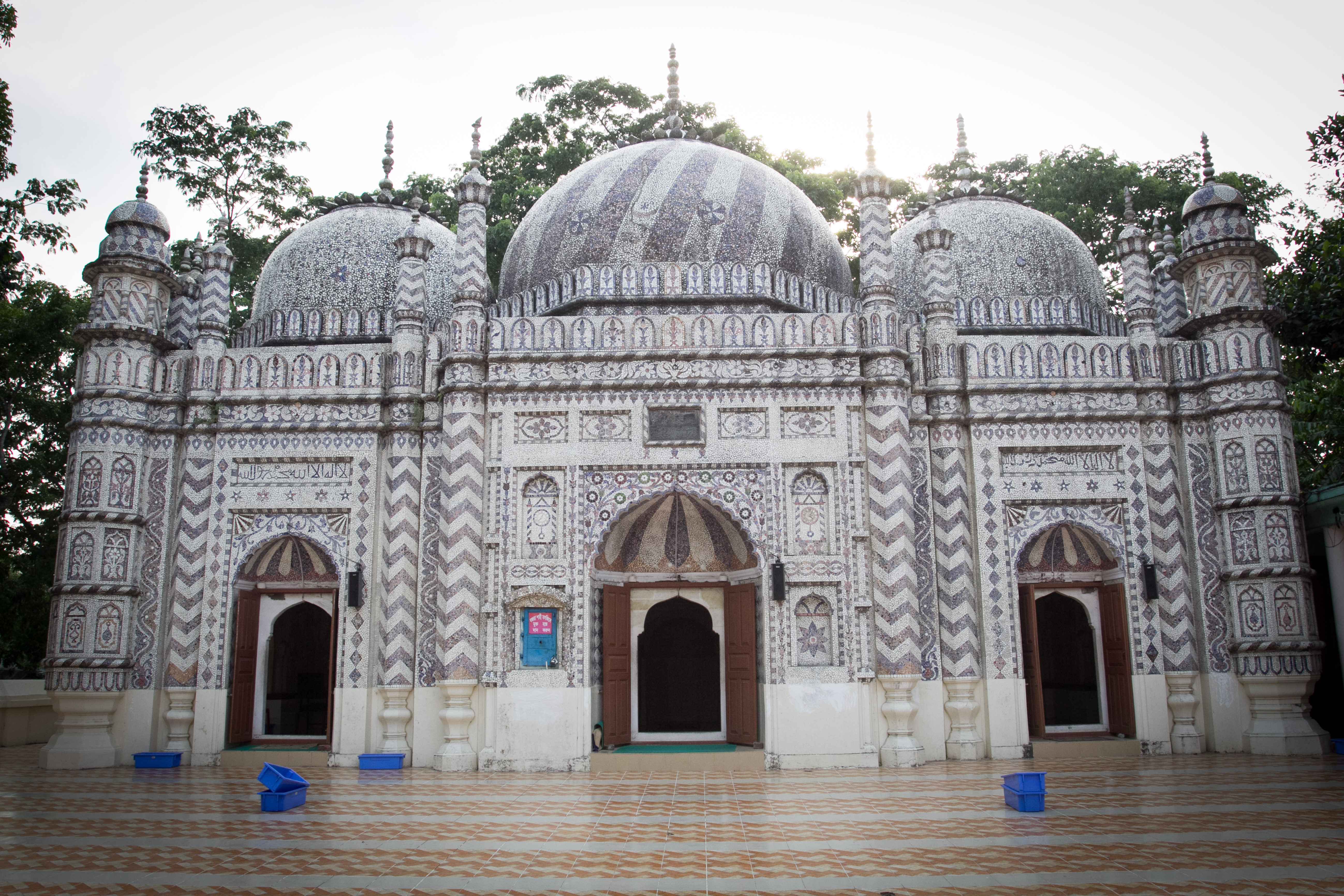Bajra Shahi Mosque on:
[Wikipedia]
[Google]
[Amazon]
Bajra Shahi Mosque ( bn, বজরা শাহী মসজিদ, Bojra Shahi Mosjid, ar, شاهي مسجد بجرا) is an 18th-century
 The mosque is located in a rural setting north of
The mosque is located in a rural setting north of
 The mosque is rectangular in plan. It has three domes, the middle one larger than those on either side, and octagonal towers at the four corners. The eastern facade has three doorways, the central one larger than the others, each projecting from the facade, opening under a half-domed vault, and flanked by slender minarets. The north and south sides each has a similar doorway.
The interior is divided into three bays by two multi-cusped arches.
The mosque is rectangular in plan. It has three domes, the middle one larger than those on either side, and octagonal towers at the four corners. The eastern facade has three doorways, the central one larger than the others, each projecting from the facade, opening under a half-domed vault, and flanked by slender minarets. The north and south sides each has a similar doorway.
The interior is divided into three bays by two multi-cusped arches.
mosque
A mosque (; from ar, مَسْجِد, masjid, ; literally "place of ritual prostration"), also called masjid, is a place of prayer for Muslims. Mosques are usually covered buildings, but can be any place where prayers ( sujud) are performed, ...
located in the Bazra Union under Sonaimuri Upazila
Sonaimuri (সোনাইমুড়ী) is a newly established upazila or sub-district in Noakhali District, Bangladesh. It consists of ten union councils or parishads - Ambarnagar, Amisha Para, Bazra, Deoti, Jayag, Nadana, Nateshwar, Sonaimu ...
of Noakhali District
Noakhali ( bn, নোয়াখালী, , New canal), historically known as Bhulua ( bn, ভুলুয়া), is a district in southeastern Bangladesh, located in the Chittagong Division. It was established as district in 1821, and offici ...
, Bangladesh
Bangladesh (}, ), officially the People's Republic of Bangladesh, is a country in South Asia. It is the eighth-most populous country in the world, with a population exceeding 165 million people in an area of . Bangladesh is among the mos ...
. It has been described as the "most notable historical monument" in the area around Maijdee
Maijdee ( bn, মাইজদী) is a city and district headquarter of Noakhali District, located in south eastern Bangladesh. It is the administrative center and the main city of Noakhali District in Chattogram Division, Bangladesh. It is al ...
.
Location
 The mosque is located in a rural setting north of
The mosque is located in a rural setting north of Noakhali
Noakhali ( bn, নোয়াখালী, , New canal), historically known as Bhulua ( bn, ভুলুয়া), is a district in southeastern Bangladesh, located in the Chittagong Division. It was established as district in 1821, and officia ...
, at the village of Bazra. The site is enclosed by an outer wall with an ornate gateway on the east, the whole situated on high ground on the western side of a ''dighi'' (reservoir
A reservoir (; from French ''réservoir'' ) is an enlarged lake behind a dam. Such a dam may be either artificial, built to store fresh water or it may be a natural formation.
Reservoirs can be created in a number of ways, including contro ...
).
History
The mosque was built by Aman Ullah in 1741-42 during the reign of the Mughal emperor Muhammad Shah. Between 1911 and 1928, Bazrazamindar
A zamindar ( Hindustani: Devanagari: , ; Persian: , ) in the Indian subcontinent was an autonomous or semiautonomous ruler of a province. The term itself came into use during the reign of Mughals and later the British had begun using it as a ...
s Khan Bahadur Ali Ahmad and Khan Bahadur Mujir Uddin Ahmad had it extensively repaired and decorated with mosaic
A mosaic is a pattern or image made of small regular or irregular pieces of colored stone, glass or ceramic, held in place by plaster/mortar, and covering a surface. Mosaics are often used as floor and wall decoration, and were particularly pop ...
s made from colored shards of ceramic. It is in a fairly good state of preservation, and is on the government Department of Archaeology's list of protected sites.
Architecture
 The mosque is rectangular in plan. It has three domes, the middle one larger than those on either side, and octagonal towers at the four corners. The eastern facade has three doorways, the central one larger than the others, each projecting from the facade, opening under a half-domed vault, and flanked by slender minarets. The north and south sides each has a similar doorway.
The interior is divided into three bays by two multi-cusped arches.
The mosque is rectangular in plan. It has three domes, the middle one larger than those on either side, and octagonal towers at the four corners. The eastern facade has three doorways, the central one larger than the others, each projecting from the facade, opening under a half-domed vault, and flanked by slender minarets. The north and south sides each has a similar doorway.
The interior is divided into three bays by two multi-cusped arches.
See also
*List of mosques in Bangladesh
Mosques Dhaka Division
Dhaka District
Faridpur District
Gazipur District
Kishoreganj District
Munshiganj District
Narayanganj District
Tangail District
Barisal Division
Barisal District
Jhalokati District
Chittagong Divisio ...
References
{{Noakhali District Mosques in Bangladesh Buildings and structures in Chittagong Division 1742 establishments in India 1740s establishments in British India Mosques completed in 1742 Sonaimuri Upazila Noakhali District